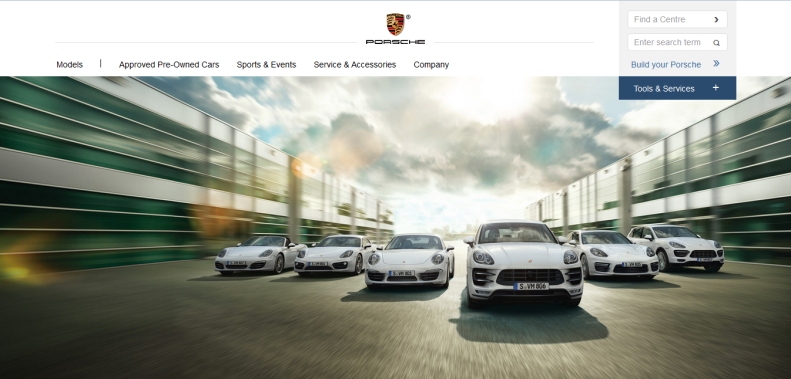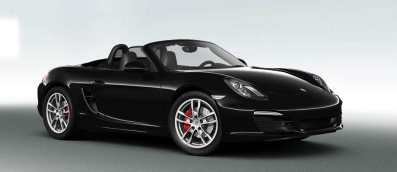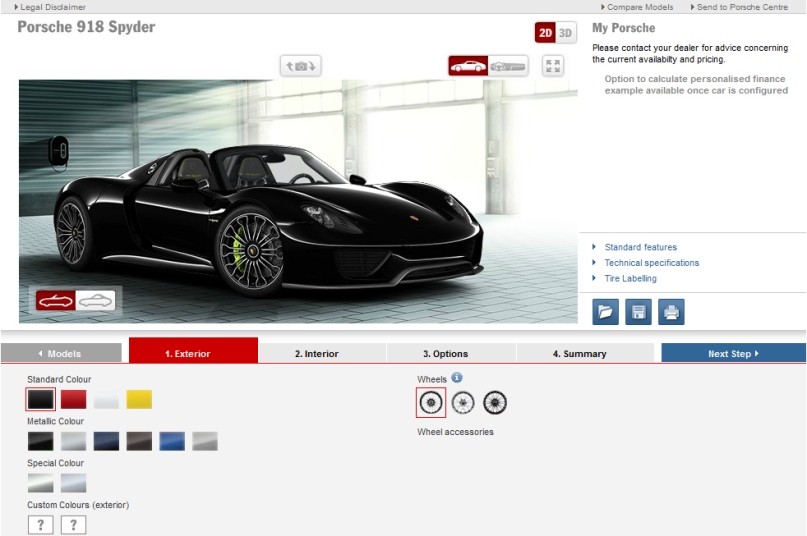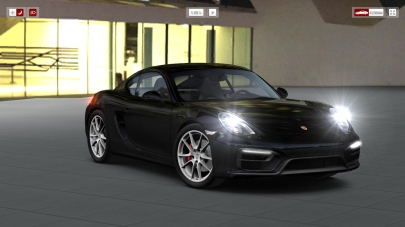 Porsche is one of those luxury brands that everyone has heard of and most of us desire to own. I was pleased to discover they have an online car configurator, and based on the company’s image of world leading quality and style, I had high hopes for their offering.
Porsche is one of those luxury brands that everyone has heard of and most of us desire to own. I was pleased to discover they have an online car configurator, and based on the company’s image of world leading quality and style, I had high hopes for their offering.
If you are interested in treating yourself, or that special person in your life, to a new set of wheels from Porsche (most of us can probably only afford the wheels) then click here to try it out.
Initially, I didn’t appreciate the complexity of all the possible options any car could have, so this review has turned into a bit of an epic. As it’s a voyage of discovery, I decided to include a lot of the detail I wrote as we are dealing with a very high-end product, and how I judge, review, observe or comment about these is an evolving process. If I skimmed over it too lightly, I didn’t feel I would really be understanding the true design, and I’m glad I persued it because my first impression did change by the end.
I’ve broken this review into 3 posts, and if you can take the time to read through, you may get a better appreciation for what goes in to a high-end configurator.
Porsche 3D Configurator Part 2 – User Experience
Porsche 3D Configurator Part 3 – Innovation
Whether you think Porsche’s configurator is good or bad, probably comes down to your taste, but what is important in terms of judging it is ‘does it achieve it’s purpose?‘.
Each 3D configurator can have many different goals, which I will touch on in a future post, but for Porsche, most people are fully aware of the brand’s quality and more often than not, the different car models. A potential buyer wouldn’t necessarily use the configurator to decide if they want a Porsche, and therefore try to learn and visualise every aspect of it, they are more likely to use it to take their time exploring and playing with all the optional extras for their potential new toy.

From my research so far, there are many uses, levels and approaches to 3D configurators, so it’s not appropriate to have a standard measure at this stage by which to judge them all, as it depends on the intended purpose, as mentioned earlier. With that in mind, I am going to review the 3D product configurators based on the following areas:
- Purpose – The main goal of the configurator. What is it intended to enable customers to achieve?
- Product Visualisation – The lighting, materials, environment, photo-realism and animation of the product on display.
- User Experience – How well the configurator achieves the above purpose in an intuitive and fluid manner.
- Application – A discussion about the scope and technology of the full application.
- Innovation – Putting the spotlight on any particular technological breakthroughs.
Purpose
The main purpose of this configurator is to allow a buyer to explore and visualise all the customisation options, confirm them and place an order.
Product Visualisation
Porsche have created a hybrid 2D and 3D solution, which I touched on in the last post, giving you the option of customising your perfect Porsche whilst viewing a 2D image or an interactive 3D visualisation. This is a very sensible idea because many interactive 3D applications struggle to work on all platforms, so users should at least be able to configure the 2D version on any browser.
2D Visualisation
You have the choice of viewing the exterior of your selected Porsche from two camera angles, front and back, and for the interior, there is just one view. The images are 3D renders that are beautifully lit and retouched to a very high standard giving an extremely clear interpretation of the shape of the chosen Porsche. Generally, the downside of 2D imagery is the challenge of showing the true form and materials of a product, but in this instance, these have been expertly created. The images are slightly more hyper-real than photo-real, but they are typical of the type of imagery you would expect in the auto industry. Photo-realism is more about adding defects, light effects, and camera artifacts which all take away from the clarity and perfection a company wants to portray of it’s product.


Car paint is a sophisticated material to emulate in CG imagery because of the complex way the true material reacts to light from different angles. When creating hundreds or thousands of possible images with all the colour variations, a simplified 2D approach to switch colours is needed to allow a cost-effective way of dealing with the volume. Often the compromise to efficiency is in the realism of the car paint. As a result, the car paint materials for these images, doesn’t quite have the realism you need to accurately choose your car colour, but they are a reasonably good representation if you already know your desired colour, and just need to visually confirm it for selection purposes.

The environment is clean and non-intrusive. There is no night-time option, like with 3D, but I think that’s OK because for 2D images, the clean studio lighting environment is important to help show the shape of the surfaces.
3D Visualisation
The alternative 3D interactive view is a better way for allowing you to get a good sense of the car’s shape and form. The lighting positions are slightly less important here because the camera movement itself allows you to evaluate the form and materials.
You have 2 environments to choose from, day and night, which I think is a great idea. This really helps you visual the car in context and also improves your ability to get a feel for the true shape of the vehicle. A photographic environment map is really important to help with realism as the reflections on the car help it sit in to the scene. Both the day and night time environments are well thought out and stylish.

The car materials aren’t completely photoreal, but they are what we have come to expect from real-time 3D models based on the limitations of photo-real effects. The car paint suffers the most here, because it is an advanced shader which is difficult to replicate in real-time, based on the way the colour changes as the surfaces faces away from you.




Pingback: Porsche 3D Configurator Part 2 – User Experience | 3D Product Configurator Design
Pingback: Unity3D Car Configurator Concept – by Wensk | 3D Product Configurator Design
Pingback: 3D Shed Configurator from IdeaRoom Tech | 3D Product Configurator Design